Mechanism of Oxytetracycline Removal by Coconut Shell Biochar Loaded with Nano-Zero-Valent Iron
Abstract
:1. Introduction
2. Materials and Methods
2.1. Materials and Reagent
2.2. Analytical Instruments and Methods
2.3. Experimental Method
Material Preparation
2.4. Batch Adsorption Experiment
2.5. Isothermal Adsorption
2.6. Adsorption Kinetics
2.7. Adsorption Thermodynamics
3. Results and Discussion
3.1. Materials Characterization
3.1.1. Scanning Electron Microscopy (SEM) Analysis
3.1.2. X-ray Diffraction (XRD) Analysis
3.1.3. Fourier-Transform Infrared Spectroscopy (FTIR) Analysis
3.1.4. X-ray Photoelectron Spectroscopy (XPS) Analysis
3.2. Batch Adsorption Experiment
3.2.1. Influence of Biochar Addition Amount on OTC Removal Effect
3.2.2. Influence of Initial pH on OTC Removal Effect
3.2.3. Influence of Cation on OTC Removal Effect
3.2.4. Influence of Anions on OTC Removal Effect
3.2.5. Influence of Ion Concentration on OTC Removal Effect
3.2.6. Adsorption Isotherm Analysis
3.2.7. Adsorption Thermodynamics
3.2.8. Adsorption Kinetics
3.3. Analysis of Degradation Products and Adsorption Mechanism
3.3.1. Degradation Products
3.3.2. Mechanism Analysis
- (1)
- nZVI-HBC, because of its biochar adsorption properties and adsorption of OTC to the surface of the material, enhances the contact between pollutants and biochar;
- (2)
- Part of the OTC is adsorbed and fixed to the surface by nZVI-HBC, and with the zero-valent iron reaction, partial degradation occurs;
- (3)
- The main degradation reactions are oxidation reaction, ring-opening reaction, and the removal of functional groups;
- (4)
- Some of the Fe2+ and Fe3+ products generated by the zero-valent iron in the air also adsorb a certain amount of OTC.
4. Conclusions
Author Contributions
Funding
Institutional Review Board Statement
Informed Consent Statement
Data Availability Statement
Acknowledgments
Conflicts of Interest
References
- World Health Organization. WHO releases the 2019 AWaRe Classification of Antibiotics. In Medical Chronicle; World Health Organization: New York, NY, USA, 2019; Volume 2019. [Google Scholar]
- Liang, X.; Chen, B.; Nie, X.; Shi, Z.; Huang, X.; Li, X. The distribution and partitioning of common antibiotics in water and sediment of the Pearl River Estuary, South China. Chemosphere 2013, 92, 1410–1416. [Google Scholar] [CrossRef] [PubMed]
- Biao, Z.; Shang, Q.; Xiangyu, G.; Kaidi, J.; Minhui, J.; Fei, L. Distribution of Antibiotic Resistance Genes in Karst River and Its Ecological Risk. Water Res. 2021, 203, 117507. [Google Scholar]
- Fernández-Calviño, D.; Bermúdez-Couso, A.; Arias-Estévez, M.; Nóvoa-Muñoz, J.C.; Fernández-Sanjurjo, M.J.; Álvarez-Rodríguez, E.; Núñez-Delgado, A. Kinetics of tetracycline, oxytetracycline, and chlortetracycline adsorption and desorption on two acid soils. Environ. Sci. Pollut. Res. 2015, 22, 425–433. [Google Scholar] [CrossRef] [PubMed]
- Mercan, Y.U.; Volkan, K.; Mikail, K.; Filiz, T.; Atalay, U.B. Adverse effects of oxytetracycline and enrofloxacin on the fertility of Saanen bucks. Trop. Anim. Health Prod. 2021, 53, 466. [Google Scholar]
- Kubra, U.; Senem, Y.G.; Emine, C.; Fatih, I.; Gamze, V. Degradation of oxytetracycline in aqueous solution by heat-activated peroxydisulfate and peroxymonosulfate oxidation. Environ. Sci. Pollut. Res. Int. 2021, 1–14. [Google Scholar] [CrossRef]
- Watkinson, A.J.; Murby, E.J.; Kolpin, D.W.; Costanzo, S.D. The occurrence of antibiotics in an urban watershed: From wastewater to drinking water. Sci. Total Environ. 2009, 407, 2711–2723. [Google Scholar] [CrossRef] [PubMed]
- Rita, A.A.; Inês, D.; Isabel, H. Zebrafish and water microbiome recovery after oxytetracycline exposure. Environ. Pollut. 2020, 272, 116371. [Google Scholar]
- Zou, S.; Xu, W.; Zhang, R.; Tang, J.; Chen, Y.; Zhang, G. Occurrence and distribution of antibiotics in coastal water of the Bohai Bay, China: Impacts of river discharge and aquaculture activities. Environ. Pollut. 2011, 159, 2913–2920. [Google Scholar] [CrossRef]
- Adriano, W.S.; Veredas, V.; Santana, C.C.; Gonçalves, L.R.B. Adsorption of amoxicillin on chitosan beads: Kinetics, equilibrium and validation of finite bath models. Biochem. Eng. J. 2005, 27, 132–137. [Google Scholar] [CrossRef]
- Zha, S.x.; Zhou, Y.; Jin, X.; Chen, Z. The removal of amoxicillin from wastewater using organobentonite. J. Environ. Manag. 2013, 129, 569–576. [Google Scholar] [CrossRef]
- Venzke, C.D.; Giacobbo, A.; Ferreira, J.Z.; Bernardes, A.M.; Rodrigues, M.A.S. Increasing water recovery rate of membrane hybrid process on the petrochemical wastewater treatment. Process. Saf. Environ. Prot. 2018, 117, 152–158. [Google Scholar] [CrossRef]
- Liang, D.H.; Hu, Y. Simultaneous sulfamethoxazole biodegradation and nitrogen conversion by Achromobacter sp. JL9 using with different carbon and nitrogen sources. Bioresour. Technol. 2019, 293, 122061. [Google Scholar] [CrossRef]
- Yang, G.-H.; Bao, D.-D.; Zhang, D.-Q.; Wang, C.; Qu, L.-L.; Li, H.-T. Removal of Antibiotics From Water with an All-Carbon 3D Nanofiltration Membrane. Nanoscale Res. Lett. 2018, 13, 146. [Google Scholar] [CrossRef] [PubMed]
- Pelalak, R.; Alizadeh, R.; Ghareshabani, E.; Heidari, Z. Degradation of sulfonamide antibiotics using ozone-based advanced oxidation process: Experimental, modeling, transformation mechanism and DFT study. Sci. Total Environ. 2020, 734, 139446. [Google Scholar] [CrossRef]
- Yun, Z.; Sheng, F.; Xuemei, D.; Wei, Z.; Cong, S.; Wei, W.; Zhenfei, J.; Wei, L. MnO2/UIO-66 improves the catalysed degradation of oxytetracycline under UV/H2O2/PMS system. J. Solid State Chem. 2021, 300, 122231. [Google Scholar]
- Ahmed, E.H.; Kubra, U.A.; Hamza, E.H.; Cem, B.U.; Oum, K.K.; Abdelmalek, D.; Najia, K.; Abdallah, Z.; Eyup, D. Removal of Oxytetracycline by Graphene oxide and Boron-doped Reduced Graphene Oxide: A combined Density Function Theory, molecular dynamics simulation and experimental study. FlatChem 2021, 27, 100238. [Google Scholar]
- Shujuan, L.; Xiaoshuang, S.; Mingyi, L.; Mengdan, Z.; Xiaohuan, D.; Xu, L.; Quan, F.; Rongbo, G. Accelerated adsorption of tetracyclines and microbes with FeOn(OH)m modified oyster shell: Its application on biotransformation of oxytetracycline in anaerobic enrichment culture. Chem. Eng. J. 2021, 425, 130499. [Google Scholar]
- Jia, M.; Wang, F.; Bian, Y.; Jin, X.; Song, Y.; Kengara, F.O.; Xu, R.; Jiang, X. Effects of pH and metal ions on oxytetracycline sorption to maize-straw-derived biochar. Bioresour. Technol. 2013, 136, 87–93. [Google Scholar] [CrossRef] [PubMed]
- Jiawei, D.; Xiangfu, M.; Yuhu, Z.; Yunjie, H. Effects of modification and magnetization of rice straw derived biochar on adsorption of tetracycline from water. Bioresour. Technol. 2020, 311, 123455. [Google Scholar]
- Imran-Shaukat, M.; Wahi, R.; Abdullah, S.M.A.A.; Ngaini, Z. Chemically Modified Coconut Shell Biochar for Removal of Heavy Metals from Aqueous Solution. Defect Diffus. Forum 2021, 411, 79–91. [Google Scholar] [CrossRef]
- Mostafa, N.A.; Farouk, S.M.; Abdelhamid, S.M.; Monazie, A.M. Optimisation and Characterisation of Bio-Adsorbent Based on Barley Straw and Coconut Shell. J. Environ. Eng. Sci. 2021, 40, 1–10. [Google Scholar] [CrossRef]
- Shen, Y.-S.; Wang, S.-L.; Tzou, Y.-M.; Yan, Y.-Y.; Kuan, W.-H. Removal of hexavalent Cr by coconut coir and derived chars—The effect of surface functionality. Bioresour. Technol. 2012, 104, 165–172. [Google Scholar] [CrossRef] [PubMed]
- Liu, H.; Xu, F.; Xie, Y.; Wang, C.; Zhang, A.; Li, L.; Xu, H. Effect of modified coconut shell biochar on availability of heavy metals and biochemical characteristics of soil in multiple heavy metals contaminated soil. Sci. Total Environ. 2018, 645, 702–709. [Google Scholar] [CrossRef] [PubMed]
- Pranoto; Martini, T.; Astuti, F.; Maharditya, W. Test the Effectiveness and Characterization of Quartz Sand/Coconut Shell Charcoal Composite as Adsorbent of Manganese Heavy Metal. IOP Conf. Ser. Mater. Sci. Eng. 2020, 858, 012041. [Google Scholar] [CrossRef]
- Xi, L.; Ling, L. Recent advances in nanoscale zero-valent iron/oxidant system as a treatment for contaminated water and soil. J. Environ. Chem. Eng. 2021, 9, 106276. [Google Scholar]
- Shao, Y.; Zhao, P.; Yue, Q.; Wu, Y.; Gao, B.; Kong, W. Preparation of wheat straw-supported Nanoscale Zero-Valent Iron and its removal performance on ciprofloxacin. Ecotoxicol. Environ. Saf. 2018, 158, 100–107. [Google Scholar] [CrossRef] [PubMed]
- Hongyi, Z.; Mengyao, Y.; Yongkang, Z.; Ali, B.S.; Ning, H.; Mengyan, M. Sodium citrate and biochar synergistic improvement of nanoscale zero-valent iron composite for the removal of chromium (Ⅵ) in aqueous solutions. J. Environ. Sci. 2022, 115, 227–239. [Google Scholar]
- Qian, L.; Zhongshan, C.; Huihui, W.; Hui, Y.; Tao, W.; Shuqin, W.; Baowei, H.; Xiangke, W. Removal of organic compounds by nanoscale zero-valent iron and its composites. Sci. Total Environ. 2021, 792, 148546. [Google Scholar]
- Yadav, R.; Sharma, A.K.; Babu, J.N. Sorptive removal of arsenite [As(III)] and arsenate [As(V)] by fuller’s earth immobilized nanoscale zero-valent iron nanoparticles (F-nZVI): Effect of Fe 0 loading on adsorption activity. J. Environ. Chem. Eng. 2016, 4, 681–694. [Google Scholar] [CrossRef]
- Li, Z.; Wang, L.; Meng, J.; Liu, X.; Xu, J.; Wang, F.; Brookes, P. Zeolite-supported nanoscale zero-valent iron: New findings on simultaneous adsorption of Cd(II), Pb(II), and As(III) in aqueous solution and soil. J. Hazard. Mater. 2018, 344, 1–11. [Google Scholar] [CrossRef]
- Yaru, L.; He-Ping, Z.; Lizhong, Z. Remediation of soil contaminated with organic compounds by nanoscale zero-valent iron: A review. Sci. Total Environ. 2021, 760, 143413. [Google Scholar]
- Premarathna, K.S.D.; Rajapaksha, A.U.; Adassoriya, N.; Sarkar, B.; Sirimuthu, N.M.S.; Cooray, A.; Ok, Y.S.; Vithanage, M. Clay-biochar composites for sorptive removal of tetracycline antibiotic in aqueous media. J. Environ. Manag. 2019, 238, 315–322. [Google Scholar] [CrossRef] [PubMed]
- Yaru, Y.; Chongyang, S.; Xiaoyuan, B.; Tiantian, L. Removal of hexavalent chromium from aqueous solution by fabricating novel heteroaggregates of montmorillonite microparticles with nanoscale zero-valent iron. Sci. Rep. 2020, 10, 12137. [Google Scholar]
- Isiuku, B.O.; Okonkwo, P.C.; Emeagwara, C.D. Batch adsorption isotherm models applied in single and multicomponent adsorption systems—A review. J. Dispers. Sci. Technol. 2021, 42, 1879–1897. [Google Scholar] [CrossRef]
- Syafiuddin, A.; Salmiati, S.; Jonbi, J.; Fulazzaky, M.A. Application of the kinetic and isotherm models for better understanding of the behaviors of silver nanoparticles adsorption onto different adsorbents. J. Environ. Manag. 2018, 218, 59–70. [Google Scholar] [CrossRef] [PubMed]
- Min, P. Biochar Adsorption of Antibiotics and its Implications to Remediation of Contaminated Soil. Water Air Soil Pollut. 2020, 231, 221. [Google Scholar]
- Jacek, P.; Katarzyna, I.; Tomasz, D. Analysis of Selected Methods Use for Calculation of the Coefficients of Adsorption Isotherms and Simplified Equations of Adsorption Dynamics with the Use of IZO Application. Materials 2021, 14, 4192. [Google Scholar]
- Akhtarul, I.M.; Ahmed, C.M.; Islam, M.M.S.; Tamez, U.M. Langmuir Adsorption Kinetics in Liquid Media: Interface Reaction Model. ACS Omega 2021, 6, 14481–14492. [Google Scholar]
- Bullen, J.C.; Saleesongsom, S.; Gallagher, K.; Weiss, D.J. A Revised Pseudo-Second-Order Kinetic Model for Adsorption, Sensitive to Changes in Adsorbate and Adsorbent Concentrations. Langmuir ACS J. Surf. Colloids 2021, 37, 3189–3201. [Google Scholar] [CrossRef] [PubMed]
- Lima, E.C.; Gomes, A.A.; Tran, H.N. Comparison of the nonlinear and linear forms of the van’t Hoff equation for calculation of adsorption thermodynamic parameters (∆S° and ∆H°). J. Mol. Liq. 2020, 311, 113315. [Google Scholar] [CrossRef]
- Weng, X.; Sun, Q.; Lin, S.; Chen, Z.; Megharaj, M.; Naidu, R. Enhancement of catalytic degradation of amoxicillin in aqueous solution using clay supported bimetallic Fe/Ni nanoparticles. Chemosphere 2014, 103, 80–85. [Google Scholar] [CrossRef] [PubMed]
- Ma, J.-F.; Xing, J.-X.; Wang, K.; Yang, H.-Y.; Fei, B.-H.; Liu, X.-E. Inspired by efficient cellulose-dissolving system: Facile one-pot synthesis of biomass-based hydrothermal magnetic carbonaceous materials. Carbohydr. Polym. 2017, 164, 127–135. [Google Scholar] [CrossRef]
- Yıldırım, G.M.; Bayrak, B. The synthesis of biochar-supported nano zero-valent iron composite and its adsorption performance in removal of malachite green. Biomass Convers. Biorefinery 2021, 1–13. [Google Scholar] [CrossRef]
- Dubey, R.S.; Ganesan, V. Visible and near-infrared wavelength-selective dielectric reflectors for light management applications. Superlattices Microstruct. 2018, 122, 228–234. [Google Scholar] [CrossRef]
- Hongcen, Y.; Shouwei, Z.; Ruya, C.; Xiaolong, D.; Zhipeng, L.; Xijin, X. Constructing the novel ultrafine amorphous iron oxyhydroxide/g-C3N4 nanosheets heterojunctions for highly improved photocatalytic performance. Sci. Rep. 2017, 7, 8686. [Google Scholar]
- Zheng, X.; Yu, N.; Wang, X.; Wang, Y.; Wang, L.; Li, X.; Hu, X. Adsorption Properties of Granular Activated Carbon-Supported Titanium Dioxide Particles for Dyes and Copper Ions. Sci. Rep. 2018, 8, 6463. [Google Scholar] [CrossRef]
- Younes, A.A.; Abdulhady, Y.A.; Shahat, N.S.; El-Din El-Dars, F.M. Removal of cadmium ions from wastewaters using corn cobs supporting nano-zero valent iron. Sep. Sci. Technol. 2021, 56, 1–13. [Google Scholar] [CrossRef]
- Lyu, H.; Tang, J.; Cui, M.; Gao, B.; Shen, B. Biochar/iron (BC/Fe) composites for soil and groundwater remediation: Synthesis, applications, and mechanisms. Chemosphere 2020, 246, 125609. [Google Scholar] [CrossRef]
- Xiao, J.; Gao, B.; Yue, Q.; Gao, Y.; Li, Q. Removal of trihalomethanes from reclaimed-water by original and modified nanoscale zero-valent iron: Characterization, kinetics and mechanism. Chem. Eng. J. 2015, 262, 1226–1236. [Google Scholar] [CrossRef]
- Zhu, F.; Wu, Y.; Liang, Y.; Li, H.; Liang, W. Degradation mechanism of norfloxacin in water using persulfate activated by BC@nZVI/Ni. Chem. Eng. J. 2020, 389, 124276. [Google Scholar] [CrossRef]
- Wang, H.; Yuan, X.; Wu, Y.; Huang, H.; Zeng, G.; Liu, Y.; Wang, X.; Lin, N.; Qi, Y. Adsorption characteristics and behaviors of graphene oxide for Zn(II) removal from aqueous solution. Appl. Surf. Sci. 2013, 279, 432–440. [Google Scholar] [CrossRef]
- Yin, C.Y.; Aroua, M.K.; Daud, W.M.A.W. Review of modifications of activated carbon for enhancing contaminant uptakes from aqueous solutions. Sep. Purif. Technol. 2006, 52, 403–415. [Google Scholar] [CrossRef]
- Gisi, S.D.; Lofrano, G.; Grassi, M.; Notarnicola, M. Characteristics and adsorption capacities of low-cost sorbents for wastewater treatment: A review. Sustain. Mater. Technol. 2016, 9, 10–40. [Google Scholar]
- Moreno-Castilla, C. Adsorption of organic molecules from aqueous solutions on carbon materials. Carbon 2003, 42, 83–94. [Google Scholar] [CrossRef] [Green Version]
- Zhang, P.; Li, Y.; Cao, Y.; Han, L. Characteristics of tetracycline adsorption by cow manure biochar prepared at different pyrolysis temperatures. Bioresour. Technol. 2019, 285, 121348. [Google Scholar] [CrossRef] [PubMed]
- Kim, J.E.; Bhatia, S.K.; Song, H.J.; Yoo, E.; Jeon, H.J.; Yoon, J.-Y.; Yang, Y.; Gurav, R.; Yang, Y.-H.; Kim, H.J.; et al. Adsorptive removal of tetracycline from aqueous solution by maple leaf-derived biochar. Bioresour. Technol. 2020, 306, 123092. [Google Scholar] [CrossRef] [PubMed]
- Jiaxin, N.; Dongmei, L.; Wei, W.; Aiwen, W.; Jialin, J.; Jiayu, T.; Zipeng, X. Hierarchical defect-rich flower-like BiOBr/Ag nanoparticles/ultrathin g-C3N4 with transfer channels plasmonic Z-scheme heterojunction photocatalyst for accelerated visible-light-driven photothermal-photocatalytic oxytetracycline degradation. Chem. Eng. J. 2021, 419, 129969. [Google Scholar]
- Wei, M.; Binghua, Y.; Wen, Z.; Yangqing, H.; Yan, Y.; Jinfen, N. Fabrication of PVDF-based piezocatalytic active membrane with enhanced oxytetracycline degradation efficiency through embedding few-layer E-MoS2 nanosheets. Chem. Eng. J. 2021, 415, 129000. [Google Scholar]
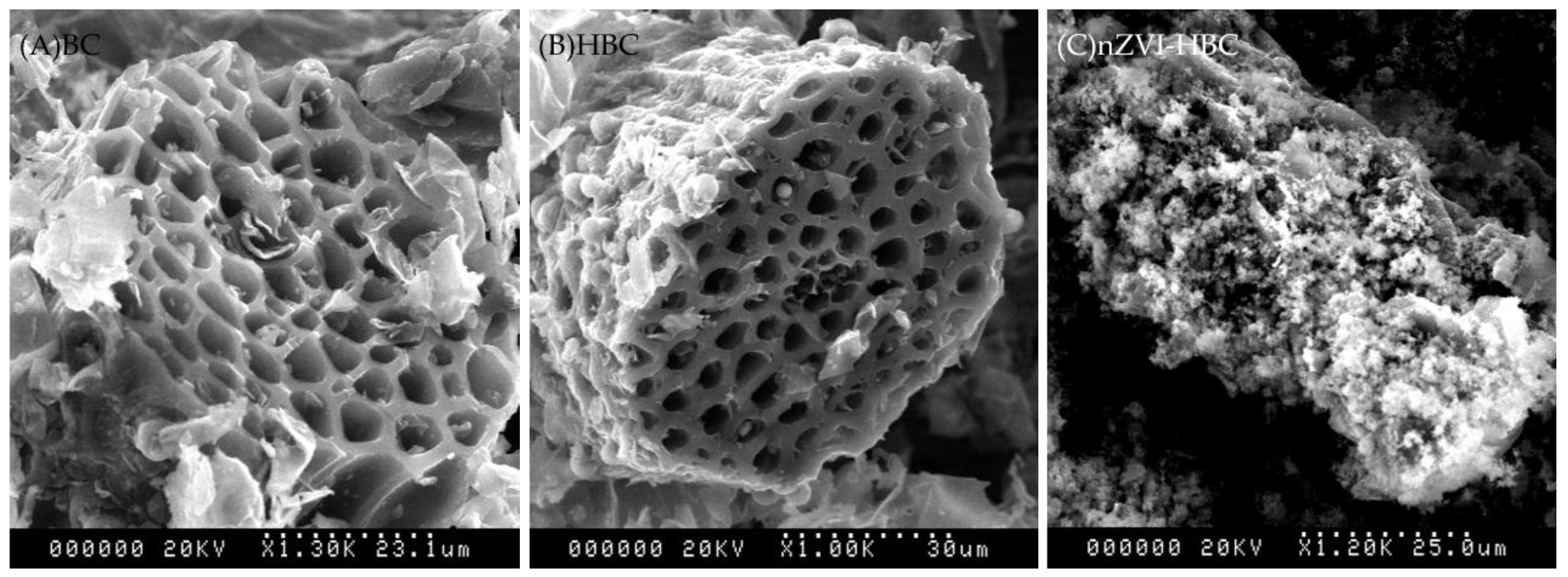
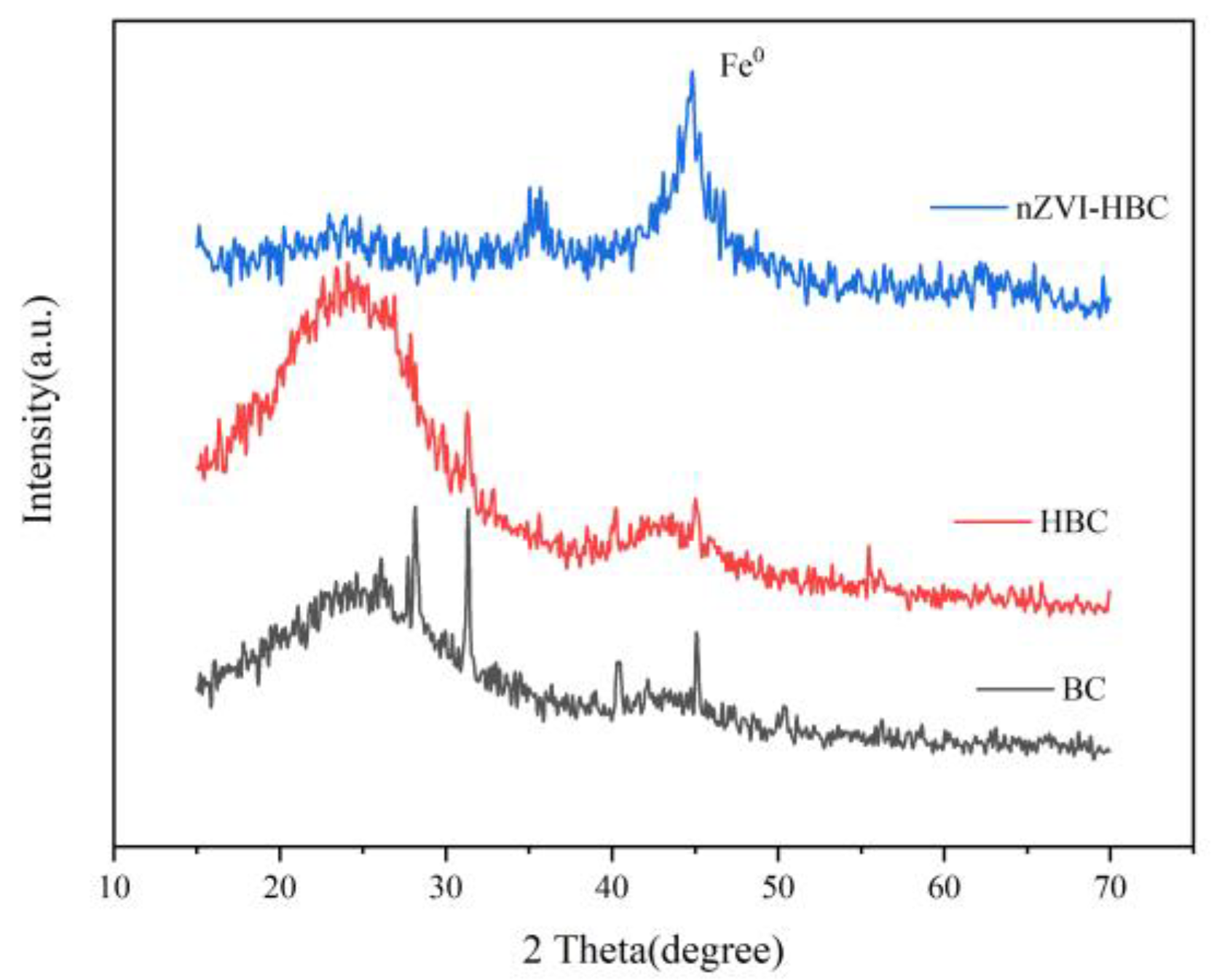
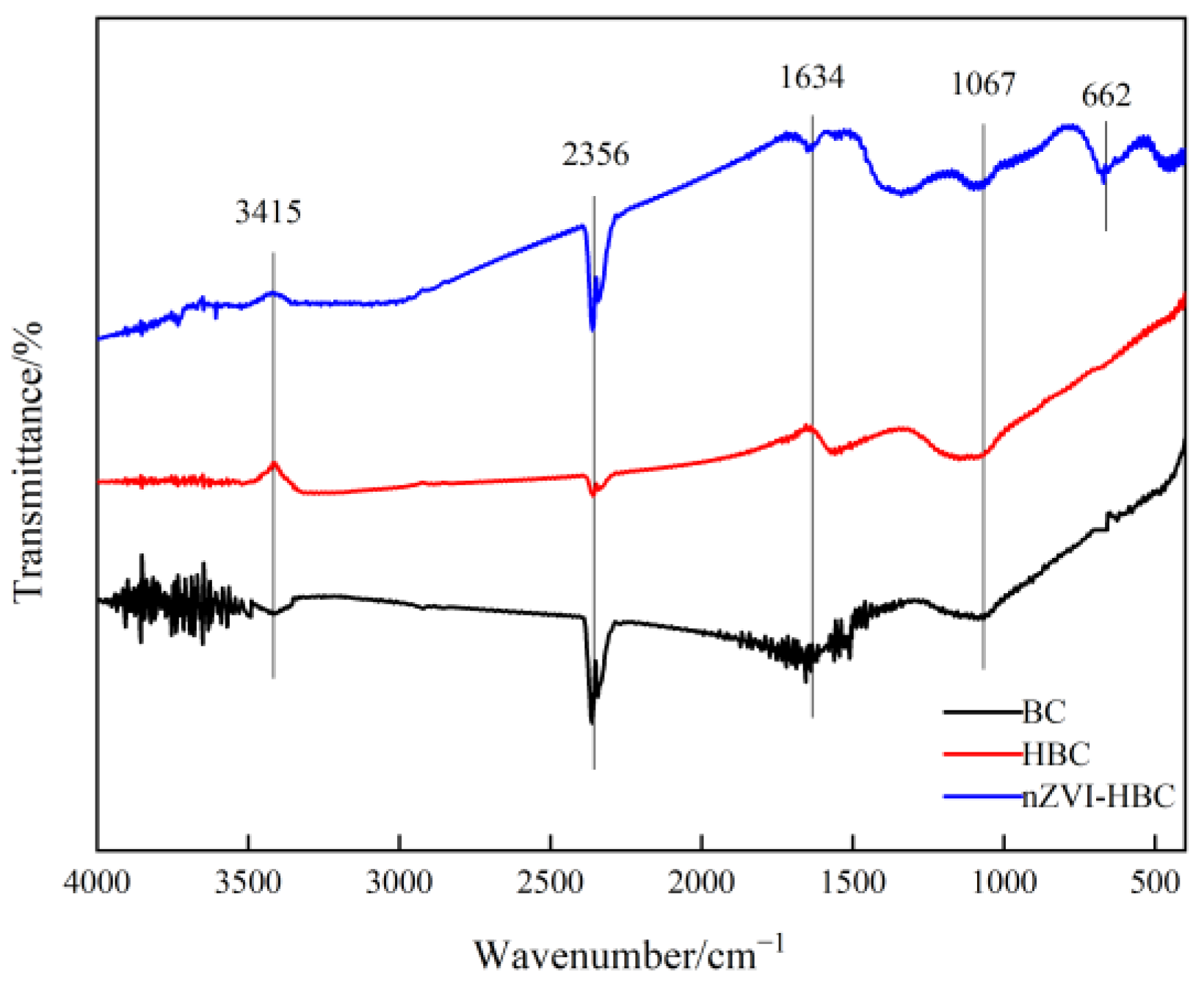
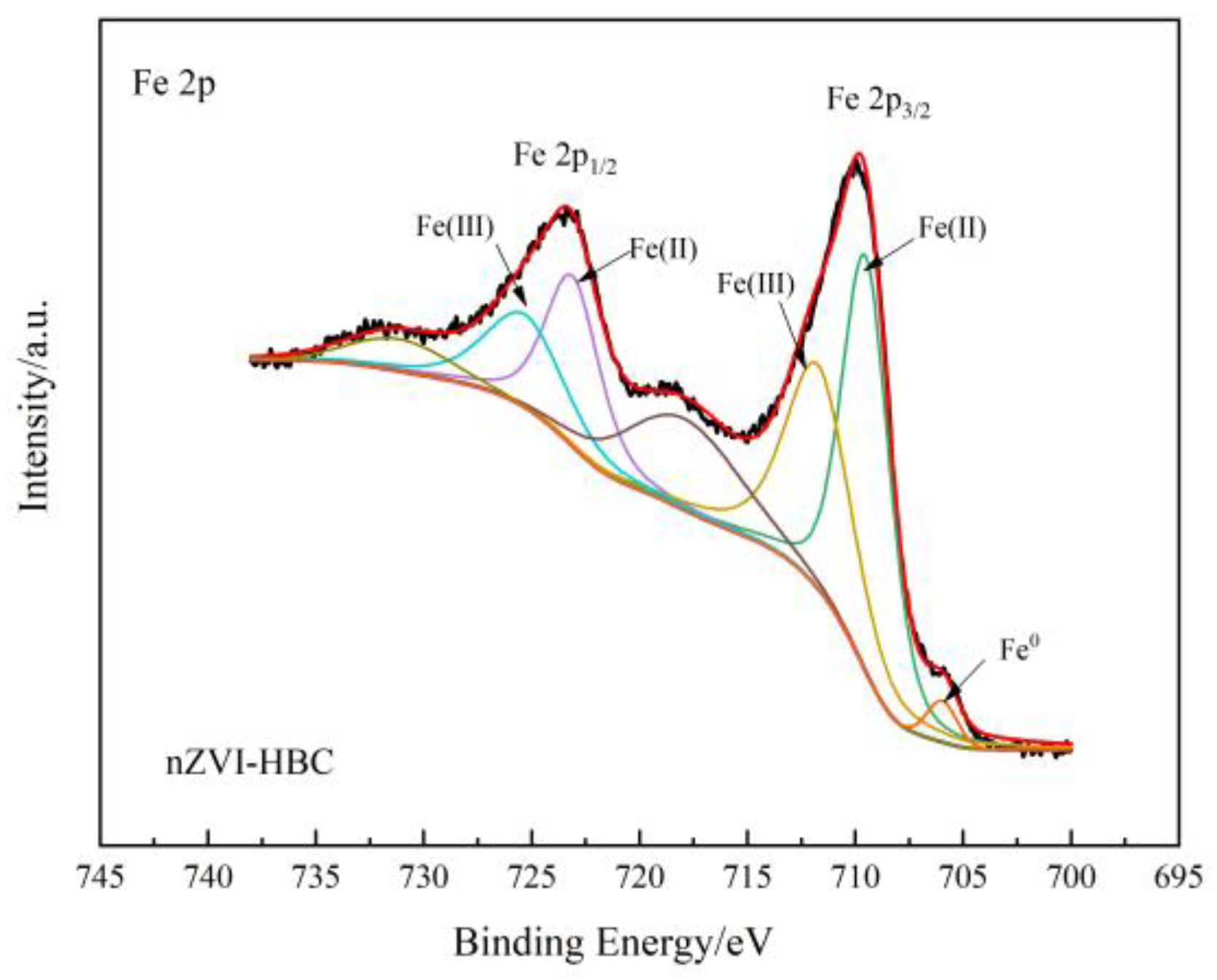
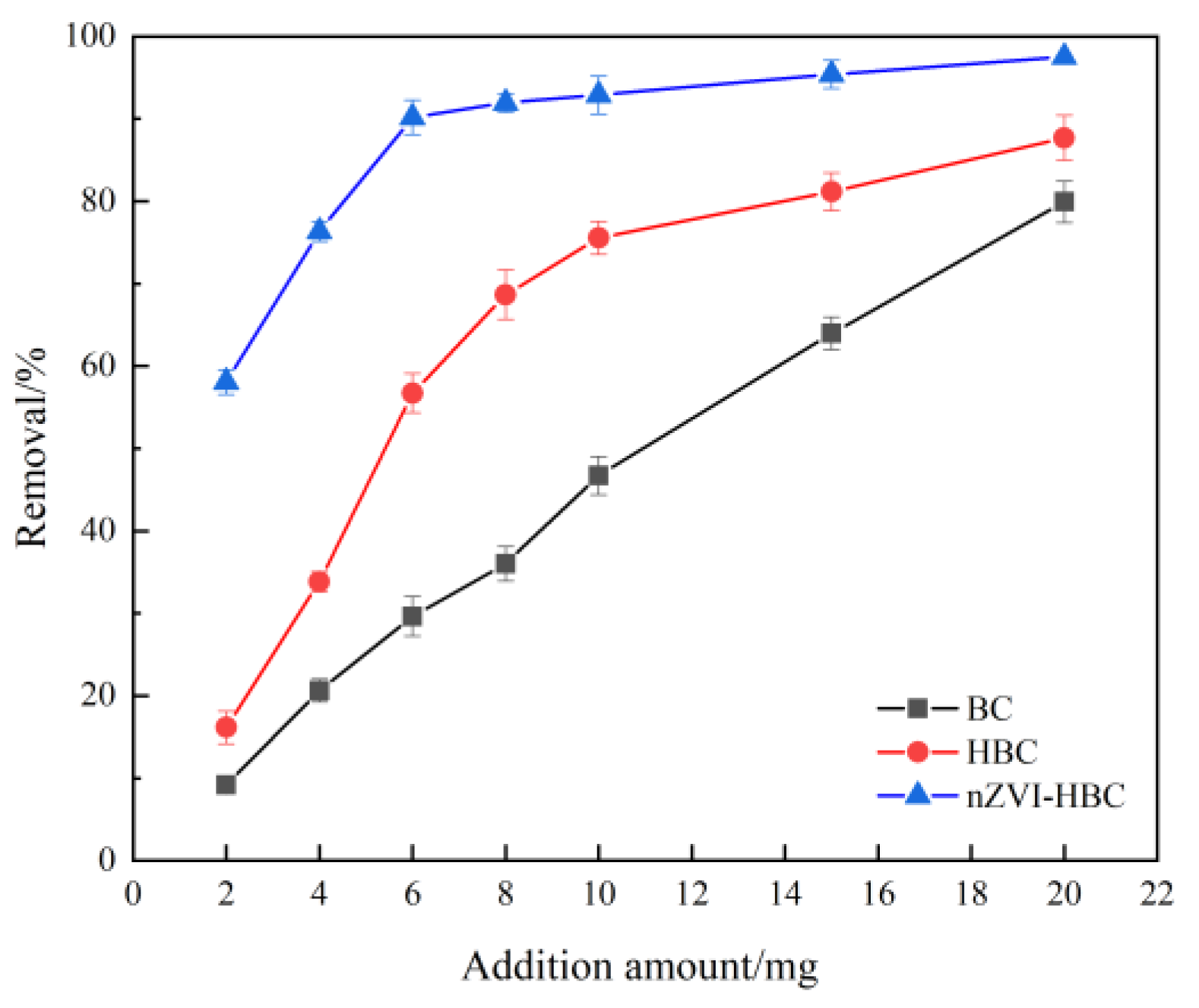
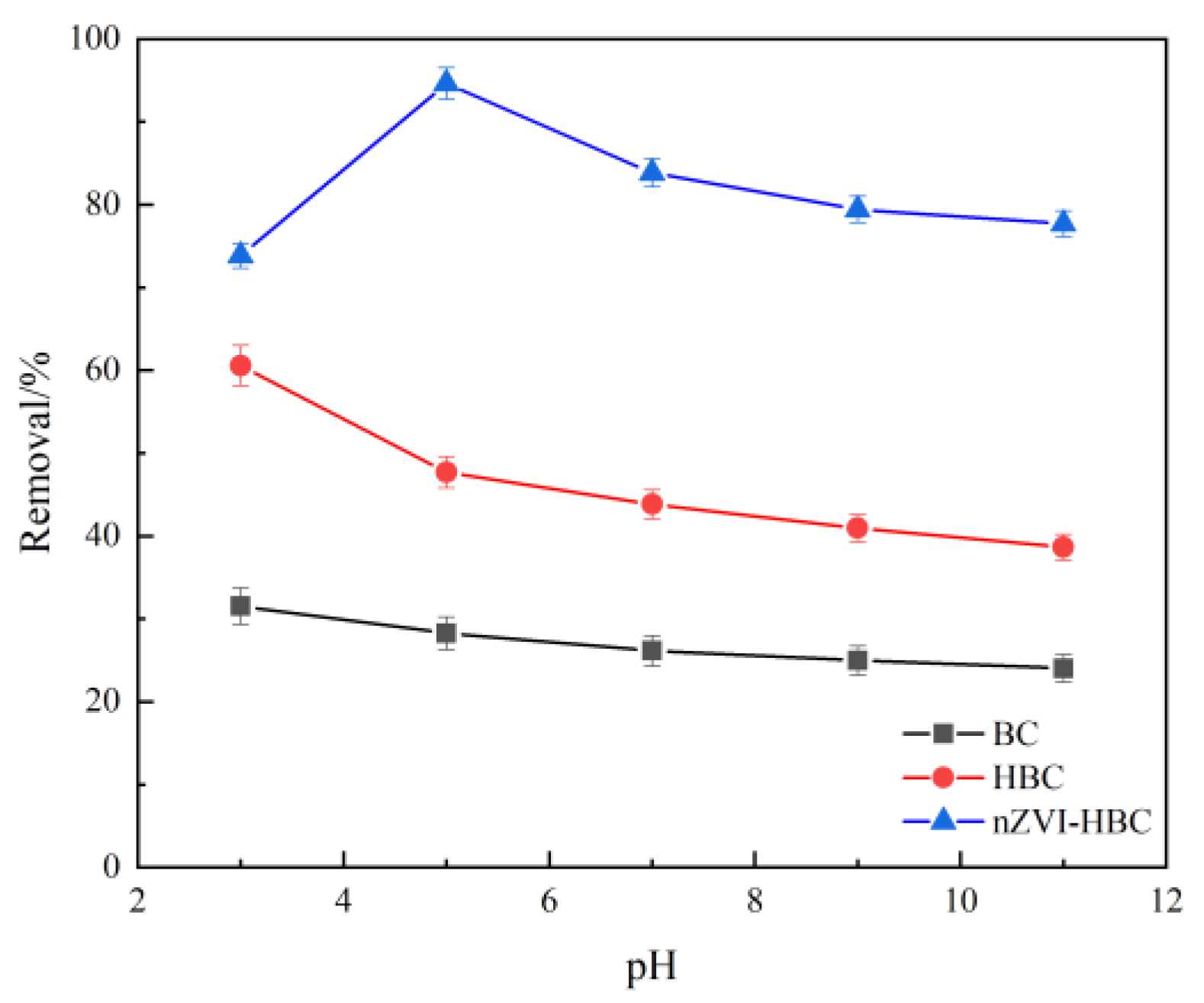
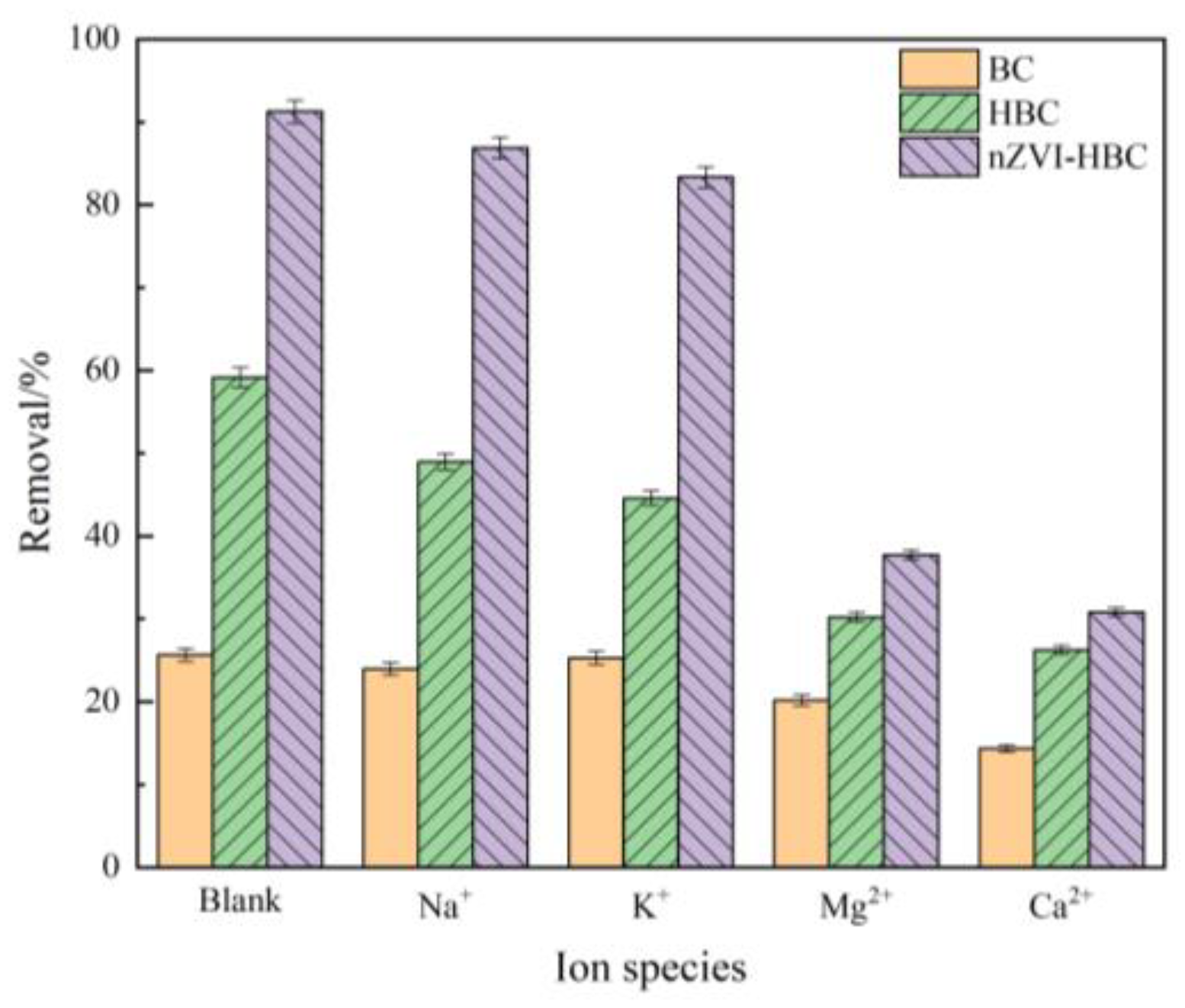
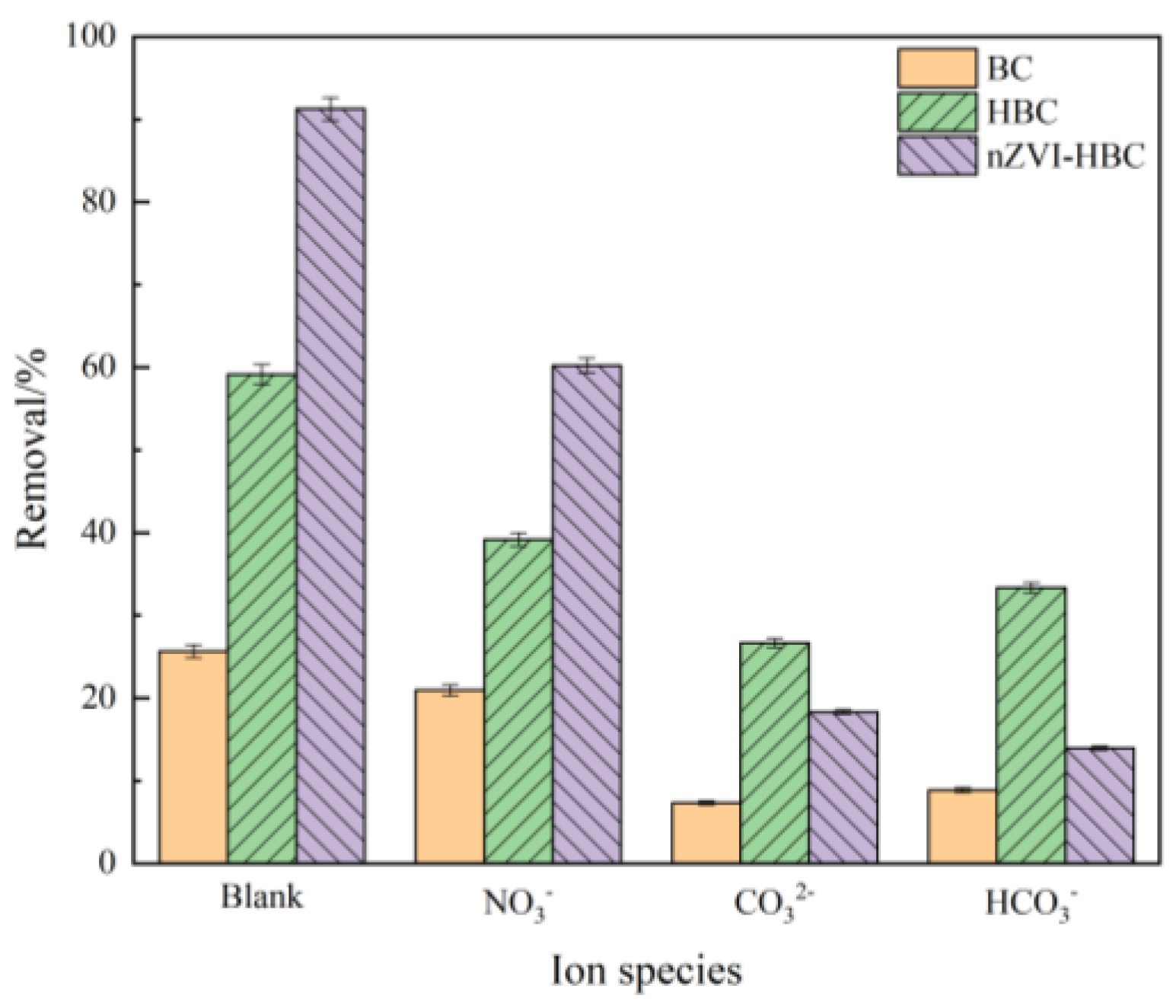
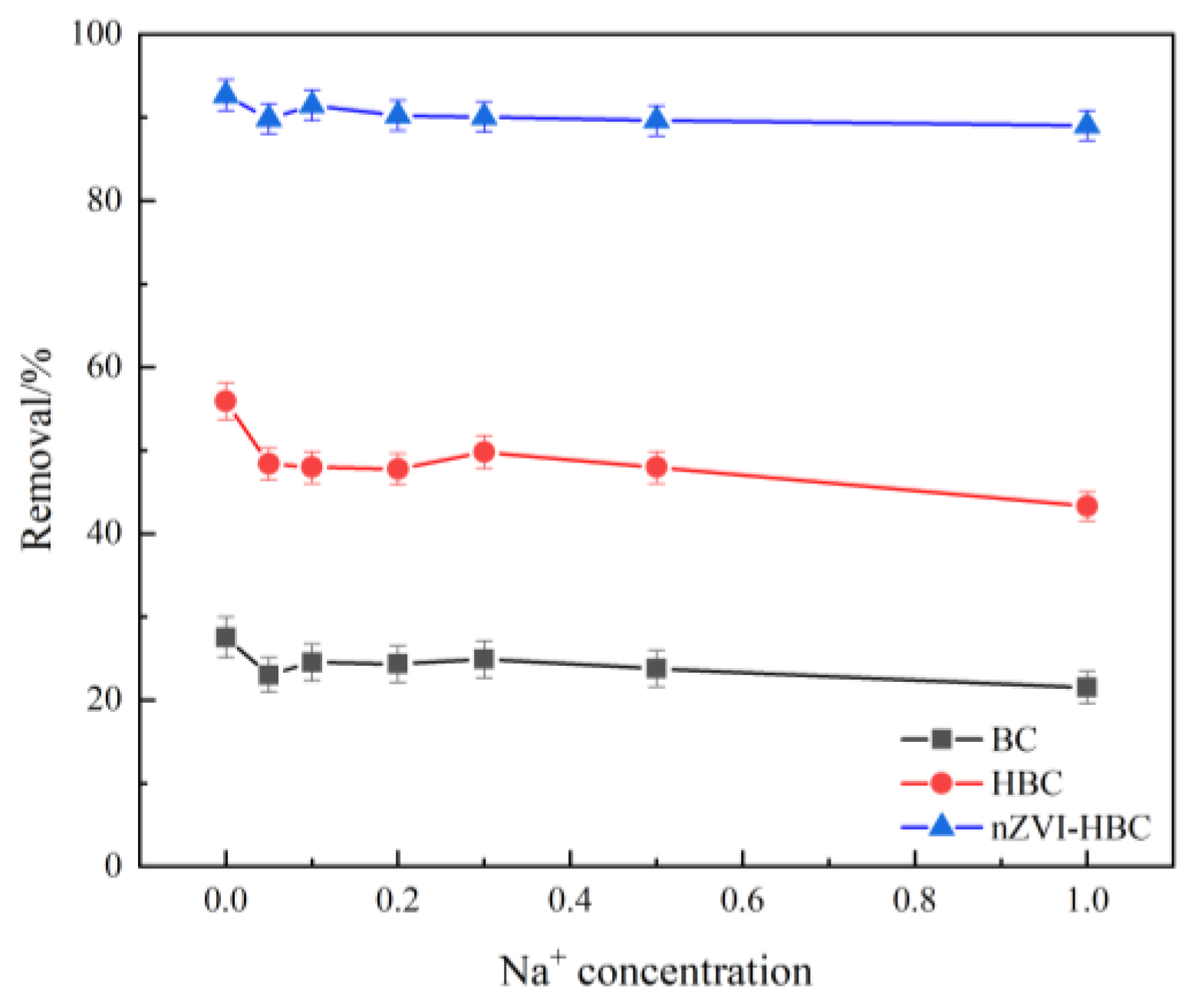
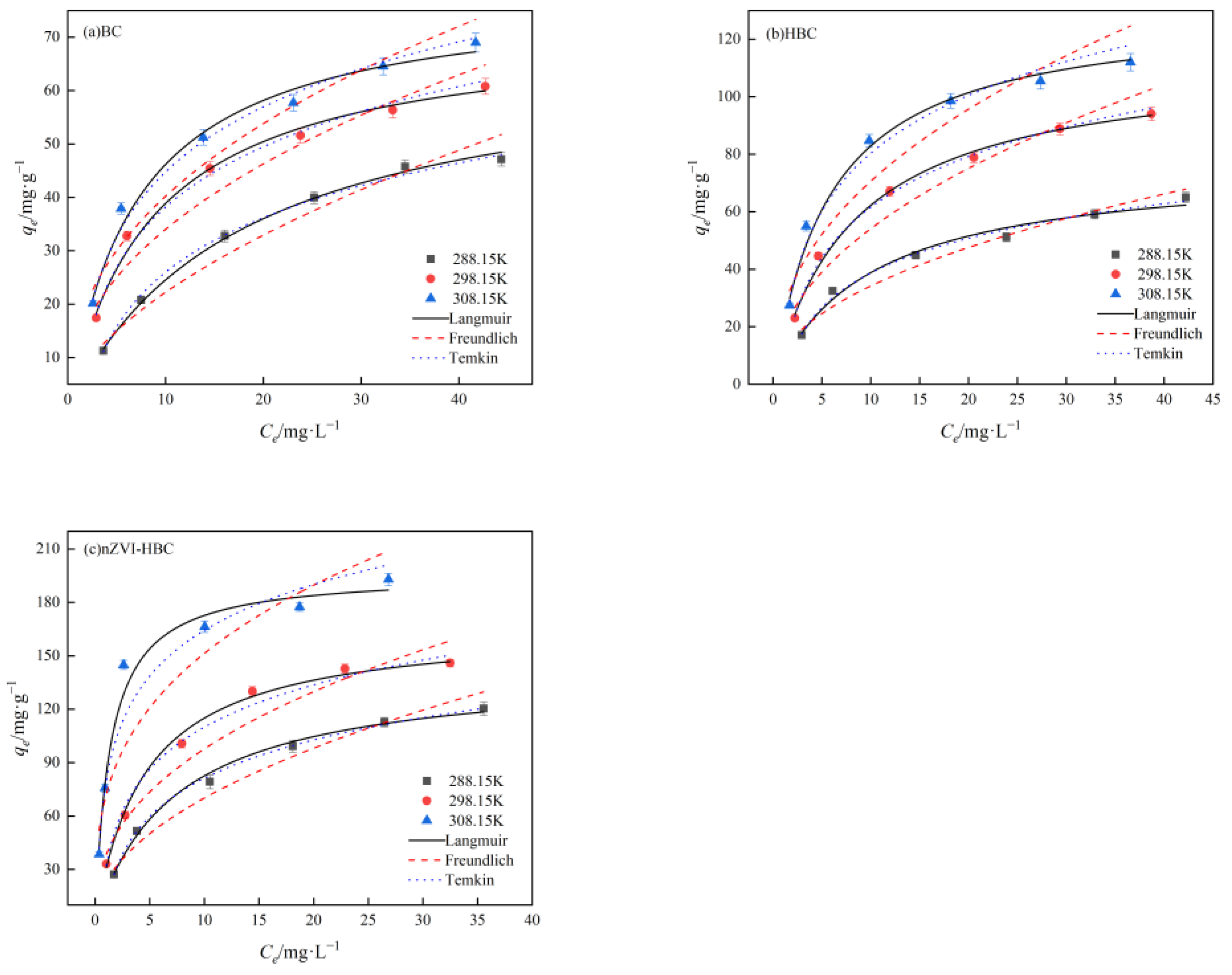
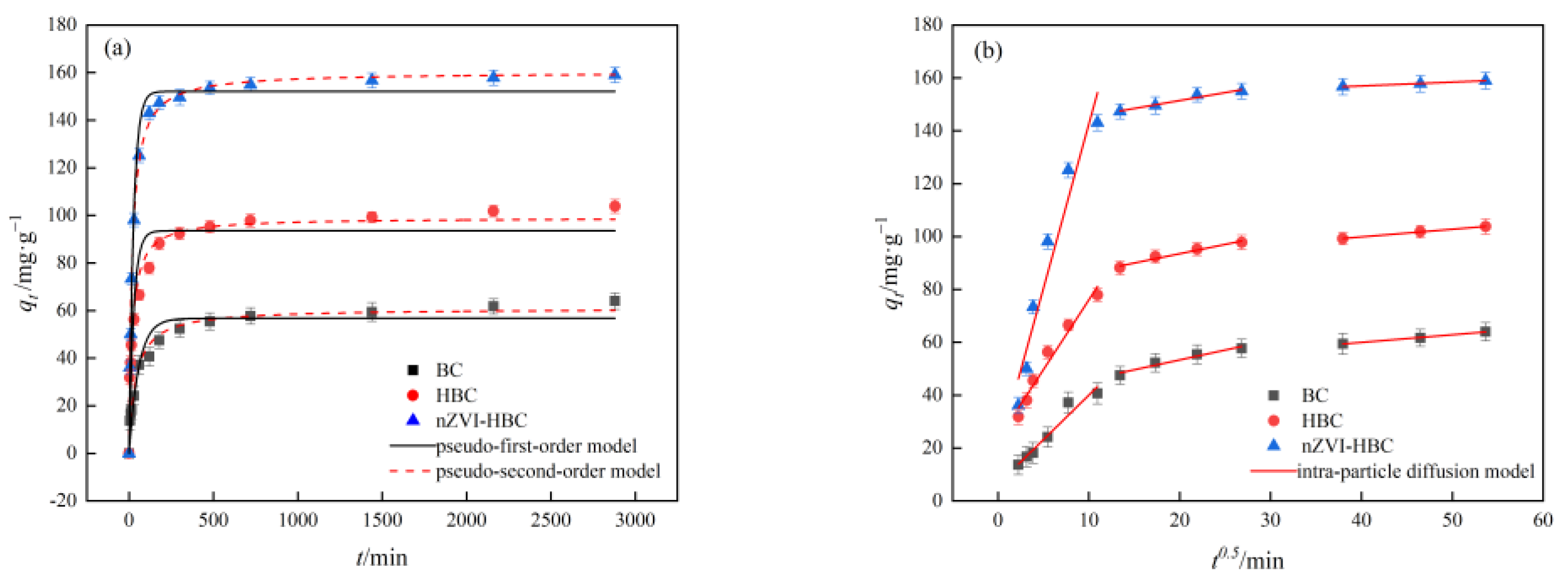
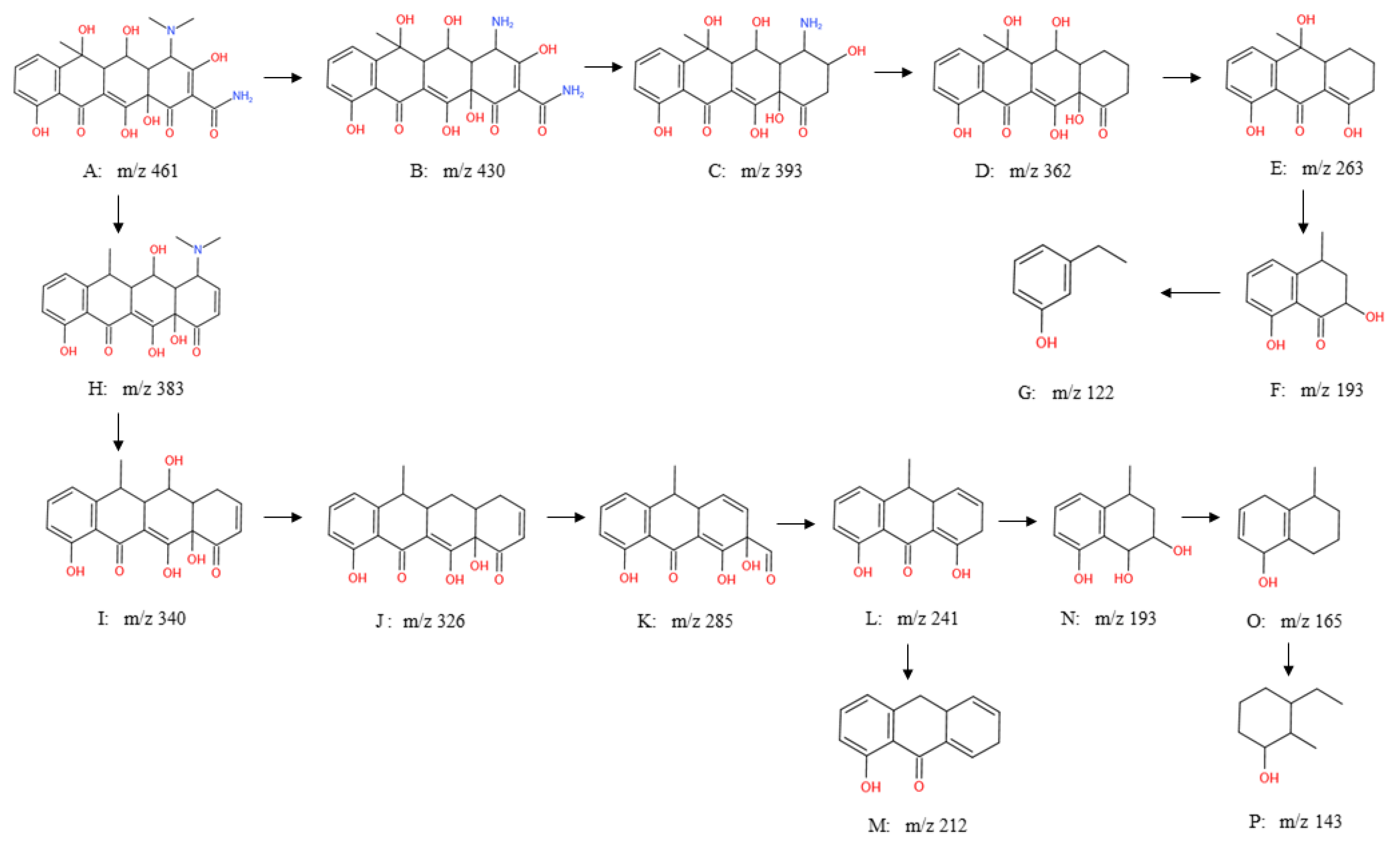
| T/K | Langmuir | Freundlich | Temkin | |||||||
|---|---|---|---|---|---|---|---|---|---|---|
| qm/mg·g−1 | KL/L·mg−1 | R2 | n | KF/mg·L−1 | R2 | B | KT/L·mg−1 | R2 | ||
| 288.15 | 67.6953 | 0.0568 | 0.9977 | 1.7603 | 6.0044 | 0.9681 | 0.1623 | 0.5816 | 0.9974 | |
| BC | 298.15 | 71.9277 | 0.1174 | 0.9892 | 2.2525 | 12.2370 | 0.9405 | 0.1520 | 1.0383 | 0.9905 |
| 308.15 | 78.6155 | 0.1421 | 0.9868 | 2.3783 | 15.2701 | 0.9416 | 0.1457 | 1.2748 | 0.9877 | |
| 288.15 | 76.7222 | 0.1025 | 0.9858 | 2.0997 | 11.4201 | 0.9555 | 0.1379 | 0.9300 | 0.9924 | |
| HBC | 298.15 | 113.3720 | 0.1217 | 0.9927 | 2.1155 | 18.2221 | 0.9465 | 0.0975 | 1.1297 | 0.9967 |
| 308.15 | 130.6579 | 0.1735 | 0.9855 | 2.1560 | 25.7669 | 0.9131 | 0.0882 | 1.5901 | 0.9845 | |
| 288.15 | 142.7134 | 0.1372 | 0.9968 | 2.0598 | 22.9187 | 0.9726 | 0.0773 | 1.3756 | 0.9992 | |
| nZVI-HBC | 298.15 | 167.2904 | 0.2199 | 0.9957 | 2.4370 | 37.9853 | 0.9582 | 0.0723 | 2.4721 | 0.9979 |
| 308.15 | 196.6985 | 0.7208 | 0.9848 | 3.0709 | 71.5141 | 0.8712 | 0.6895 | 8.3281 | 0.9956 | |
| T/K | ΔG/KJ·mol−1 | ΔH/KJ·mol−1 | ΔS/KJ·mol−1·K−1 | |
|---|---|---|---|---|
| 288.15 | −7.8202 | |||
| BC | 298.15 | −9.8900 | 32.7392 | 0.1409 |
| 308.15 | −10.7110 | |||
| 288.15 | −9.2327 | |||
| HBC | 298.15 | −9.9790 | 17.6457 | 0.0929 |
| 308.15 | −11.2227 | |||
| 288.15 | −9.9326 | |||
| nZVI-HBC | 298.15 | −11.4459 | 61.5413 | 0.2469 |
| 308.15 | −14.8714 |
| Pseudo-First-Order Dynamics Model | Pseudo-Second-Order Dynamics Model | |||||
|---|---|---|---|---|---|---|
| k1/min−1 | qe/ mg·g−1 | R2 | k2/min−1 | qe/ mg·g−1 | R2 | |
| BC | 0.0174 | 56.7510 | 0.9248 | 0.0004 | 60.8867 | 0.9760 |
| HBC | 0.0361 | 93.5487 | 0.9064 | 0.0005 | 99.0229 | 0.9723 |
| nZVI-HBC | 0.0376 | 152.1172 | 0.9854 | 0.0003 | 160.2055 | 0.9976 |
| Ki1 /mg·g−1·min−0.5 | C1 | R12 | Ki2 /mg·g−1·min−0.5 | C2 | R22 | Ki3 /mg·g−1·min−0.5 | C3 | R32 | |
|---|---|---|---|---|---|---|---|---|---|
| BC | 3.3681 | 6.3466 | 0.9379 | 0.7462 | 38.4293 | 0.9281 | 0.2888 | 48.4239 | 0.9952 |
| HBC | 5.2774 | 23.2910 | 0.9596 | 0.7041 | 79.4408 | 0.9543 | 0.2898 | 88.2895 | 0.9990 |
| nZVI-HBC | 12.4327 | 18.3370 | 0.9176 | 0.5996 | 139.4657 | 0.9457 | 0.1444 | 151.2029 | 0.9952 |
Publisher’s Note: MDPI stays neutral with regard to jurisdictional claims in published maps and institutional affiliations. |
© 2021 by the authors. Licensee MDPI, Basel, Switzerland. This article is an open access article distributed under the terms and conditions of the Creative Commons Attribution (CC BY) license (https://creativecommons.org/licenses/by/4.0/).
Share and Cite
Li, Q.; Zhao, S.; Wang, Y. Mechanism of Oxytetracycline Removal by Coconut Shell Biochar Loaded with Nano-Zero-Valent Iron. Int. J. Environ. Res. Public Health 2021, 18, 13107. https://doi.org/10.3390/ijerph182413107
Li Q, Zhao S, Wang Y. Mechanism of Oxytetracycline Removal by Coconut Shell Biochar Loaded with Nano-Zero-Valent Iron. International Journal of Environmental Research and Public Health. 2021; 18(24):13107. https://doi.org/10.3390/ijerph182413107
Chicago/Turabian StyleLi, Qi, Siyu Zhao, and Yuhang Wang. 2021. "Mechanism of Oxytetracycline Removal by Coconut Shell Biochar Loaded with Nano-Zero-Valent Iron" International Journal of Environmental Research and Public Health 18, no. 24: 13107. https://doi.org/10.3390/ijerph182413107
APA StyleLi, Q., Zhao, S., & Wang, Y. (2021). Mechanism of Oxytetracycline Removal by Coconut Shell Biochar Loaded with Nano-Zero-Valent Iron. International Journal of Environmental Research and Public Health, 18(24), 13107. https://doi.org/10.3390/ijerph182413107





